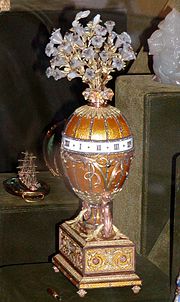Brukar:Bep/Sandkasse/Omsetjingar/Fabergé-egg
Eit Fabergé-egg er eitt av femti juvelpryda påskegg laga av Peter Carl Fabergé for dei russiske tsarane i tida mellom 1885 og 1917. Egga er rekna for å vere mellom meisterverka innan juvelkunsten.
Fabergé (eller meir nøyaktig, gullsmedane hans) laga det første egget i 1885 på oppdrag frå tsar Alexander III av Russland som ei påskeoverrasking til kona hans Maria Fjodorovna. På utsida såg det ut som eit egg av kvitt emaljert gull, men opna ein egget såg ein den gylne eggeplommen. Plommen hadde ein gylden hane inni seg - hanen bar ei miniatyrkrone med ein rubin på innsida.
Kona vart så begeistra for denne gåva at Alexander utnemnde Fabergé til hoffleverandør, og bestilde ein liknande påskepresang kvart år framover. Det éinaste kravet var at egget måtte vere unkikt og innehalde ei overrasking. Nicholas II heldt fram denne tradisjonen og utvida bestillinga til ein årleg presang til både kona Alexandra Fjodorovna og mor hans.
Ettersom House of Fabergé gjorde stor suksess, kunne førebuingane av egga ta opptil eitt år; når eit tema først var valt sette fleire dusin artisanar i gang med å fullføre prosjektet.

Tema og utsjånad på egga varierte stort. Til dømes var Den transsibiriske jarnbana-egget frå 1900 omkransa av eit ordinært, metallisk og grått band med eit kart av jarnbana si rute. På innsida finn ein heile toget i gull.
57 egg vart produsert. St. George-orden-egget forlét Russland med Maria Fjodorovna i 1918, men resten vart verande, gløymde i tumultane frå den Russiske revolusjonen i 1917|Russiske revolusjonen. Fleire egg forsvann i plyndringane medan resten vart plasserte i Kremlin sitt hvelv. I og etter 1939
Fifty seven eggs were produced in all. The Order of St. George Egg left Russland with Maria Fyodorovna in 1918, but the rest remained, forgotten in the turmoil of the Russlandn Revolution. Several disappeared in the looting, and the rest were boxed up in the vaults of the Kremlin. In and after 1930, Stalin had fourteen sold in western art auctions to raise cash, some for as little as US$400. Many of these were bought by Armand Hammer.
As of 2003, just ten eggs were still in Russland, all on display at the Kremlin Armory Museum. Another nine were purchased by Viktor Vekselberg in February 2004 from the Forbes family in New York city. The Vekselberg collection arrived in Russland in July 2004. Smaller collections are in the Virginia Museum of Fine Arts, New Orleans Museum of Art, and other museums around the world. Four eggs are in private collections, and eight are still missing.
In the modern day, a number of companies, including Victor Mayer, the inheritor of the Fabergé brand, offer "Fabergé eggs" whose designs are inspired by the originals.

See also
[endre | endre wikiteksten]- Easter eggs
- Egg decorating
- Guilloché
List of Fabergé eggs
[endre | endre wikiteksten]- 1885 Hen (Vekselberg Collection, Russland)
- 1886 Hen with Sapphire Pendant (missing)
- 1887 Blue Serpent Clock (Prince Rainier III of Monaco Collection, Monaco)
- 1888 Cherub with Chariot (missing)
- 1889 Necessaire (missing)
- 1890 Danish Palaces (New Orleans Museum of Art, USA)
- 1891 Memory of Azov (Kremlin Armoury Museum, Moskva)
- 1892 Diamond Trellis (private collection)
- 1893 Caucasus (New Orleans Museum of Art, New Orleans, Louisiana, USA)
- 1894 Renaissance (Vekselberg Collection, Russland)
- 1895 Rosebud (Vekselberg Collection, Russland)
- 1895 Twelve Monograms (Hillwood Museum, Washington, DC, USA)
- 1896 Revolving Miniatures (Virginia Museum of Fine Arts, Richmond, Virginia, USA)
- 1896 Alexander III (missing)
- 1897 Coronation (Vekselberg Collection, Russland) - This egg is the object to be stolen to decide which thief is best in the film Ocean's Twelve, the sequel to Ocean's Eleven.
- 1897 Mauve Enamel (missing)
- 1898 Lilies of the Valley (Vekselberg Collection, Russland). The first half of the James Bond film Octopussy concerns the theft and subsequent auction of this egg, which contains a model of the imperial state coach.
- 1898 Pelican (Virginia Museum of Fine Arts, Richmond, Virginia, USA)
- 1899 Bouquet of Lilies Clock (Kremlin Armoury Museum, Moskva)
- 1899 Pansy (private collection)
- 1900 Cockerel (Vekselberg Collection, Russland)
- 1900 Trans-Siberian Railway (Kremlin Armoury Museum, Moskva)
- 1901 Basket of Wild Flowers (Royal Collection of Her Majesty Queen Elizabeth II)
- 1901 Gatchina Palace (Walters Art Museum, Baltimore, USA)
- 1902 Clover (Kremlin Armoury Museum, Moskva)
- 1902 Empire Nephrite (missing)
- 1903 Peter the Great (Virginia Museum of Fine Arts, Richmond, Virginia, USA)
- 1903 Danish Jubilee (missing)

- 1906 Moskva Kremlin (Kremlin Armoury Museum, Moskva)
- 1906 Swan (Edouard and Maurice Sandoz Foundation, Switzerland)
- 1907 Rose Trellis (Walters Art Museum, Baltimore, USA)
- 1907 Cradle with Garlands (private collection)
- 1908 Alexander Palace (Kremlin Armoury Museum, Moskva)
- 1908 Peacock (Edouard and Maurice Sandoz Foundation, Switzerland)
- 1909 Standart (Kremlin Armoury Museum, Moskva)
- 1909 Alexander II Commemorative (missing)
- 1910 Alexander III Equestrian (Kremlin Armoury Museum, Moskva)
- 1910 Colonnade (Royal Collection of Her Majesty Queen Elizabeth II)
- 1911 Bay Tree (Vekselberg Collection, Russland)
- 1911 Fifteenth Anniversary (Vekselberg Collection, Russland)
- 1912 Czarevich (Virginia Museum of Fine Arts, Richmond, Virginia, USA)
- 1912 Napoleonic (New Orleans Museum of Art, USA)
- 1913 Romanov Tercentenary (Kremlin Armoury Museum, Moskva)
- 1913 Winter (private collection)
- 1914 Mosaic (Royal Collection of Her Majesty Queen Elizabeth II)
- 1914 Grisaille (Hillwood Museum, Washington, DC)
- 1915 Red Cross with Imperial Portraits (Virginia Museum of Fine Arts, Richmond, Virginia, USA)
- 1915 Red Cross with Triptych (Cleveland Museum of Art, Cleveland, Ohio, USA)
- 1916 Order of St. George (Vekselberg Collection, Russland)
- 1916 Steel Military (Kremlin Armoury Museum, Moskva)
- 1917 Constellation Egg (Fersman Mineralogical Institute, Moskva)
- 1917 Karelian Birch Egg (Russlandn National Museum, Moskva)
External links
[endre | endre wikiteksten]Text is available under the CC BY-SA 4.0 license; additional terms may apply.
Images, videos and audio are available under their respective licenses.
